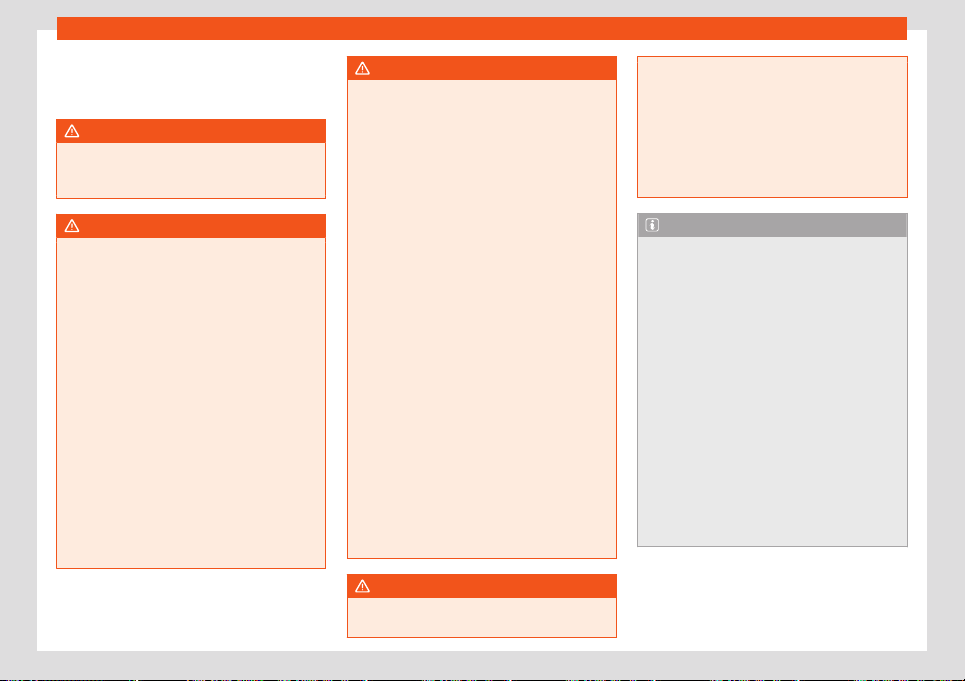Loading ...
Loading ...
Loading ...

Towing bracket device*
drawbar load on the ball joint of the t
o
wing
br
ack
et, but
do not exceed the specified lim-
it.
WARNING
Never use the trailer to transport people,
since it would put their life in danger and is
also pr
ohibited.
WARNING
Undue use of the towing bracket may
cause injury and accidents.
●
Only use the towing bracket if it is in a
perfect state of repair and is pr
operly se-
cured.
●
Never modify or repair the towing bracket
in any way.
●
In order to reduce the danger of injury in
the event of rear-end collisions and to
avoid injury to pedestrians and cyclists
when parking the vehicle, cover or remove
the tow hook when you are not using a trail-
er.
●
Never fit a towing bracket “with weight
distribution” or “load compensation”. The
vehicle has not been designed for this type
of towing bracket. The towing bracket
could fail and the trailer could be released
from the vehicle.
WARNING
Driving with a trailer and transporting
heavy or large objects can affect driving
pr
operties and even cause an accident.
●
Always secure the load properly using
belts or straps that are suitable and in
good condition.
●
Adapt your speed and driving style at all
times to suit visibility, weather, road and
traffic conditions.
●
Trailers with a high centre of gravity are
more likely to overturn than those with a
low one.
●
Avoid sudden braking and manoeuvres.
●
Take great care when overtaking.
●
Reduce speed immediately if you notice
that the trailer is swaying, however slightly.
●
Never drive at more than 80 km/h
(50 mph) when towing a trailer (or at more
than 100 km/h (60 mph) in exceptional cir-
cumstances). This also applies in countries
where driving at higher speeds is permit-
ted. Take into account the speed limit for
vehicles with trailers in the corresponding
country, as it could be less than the speed
limit for vehicles without a trailer.
●
Never attempt to “straighten” the towing
vehicle and trailer while accelerating.
WARNING
If the towing bracket has been retrofitted
by a non-SEAT workshop, the Start
-Stop
system must be disconnected manually
whenever driving with a trailer
. Otherwise
the brake system could be damaged and
could consequently cause a serious acci-
dent or injury.
●
Always disconnect the Start-Stop system
manually when using a towing bracket that
has not been fitted by a SEAT workshop.
Note
●
Bef
ore hitching or unhitching a tr
ailer, al-
ways deactivate the anti-theft alarm
›››
page 97. Otherwise, the tilt sensor could
cause the alarm to go off.
●
Do not drive with a trailer for the engine's
first 1000 km
›››
page 263.
●
SEAT recommends that, if possible, the
tow hook be removed or covered when it is
not going to be used. In the event of a rear-
end collision, the damage to the vehicle
could be greater if the tow hook is fitted.
●
Some retrofitted towing brackets cover
the rear towing eye. In these cases, the
towing eye should not be used for tow-
starting or for towing other vehicles. For
this reason, if the vehicle has been retrofit-
ted with a towing bracket, always keep the
tow hook in the vehicle when you remove it.
325
Loading ...
Loading ...
Loading ...